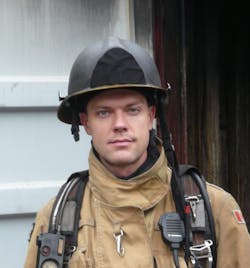FHWorld16: Building a Robust Fire Dynamics Training Program
Firefighter training is one of the central points of Firehouse World 2016. So is introducing the American fire service to some of the critical topics that international fire service leaders have been working on for years. Ian Bolton’s Tuesday Firehouse World session, “Developing and Implementing a Comprehensive Fire Dynamics Training Program,” brings the two together, helping attendees garner the skills to develop and implement their own in-depth and advanced fire dynamics programs at their departments.
I had a chance to catch up with Bolton—a firefighter and the program director for the District of North Vancouver Fire and Rescue Services—about his session and why it is so important for departments to have a comprehensive fire dynamics training program. “Fundamentally, it’s critical that we do the best we can to improve our efficiency and safety,” Bolton said. “Nowadays we have the research and engineering principles available to share with the line firefighters to apply on the fireground.”
Bolton emphasized that all departments—from small, rural departments to large, urban departments—can pursue this type of training. The problem, he said, is that there aren’t a lot of resources available, and much of the formal education options are playing catch up. Fortunately, his agency has developed a program that focuses on fire dynamics—and they make it widely available. “As the director who is ultimately responsible for development, I am constantly giving the materials away for free to anyone who wants it,” he said. “We need to create opportunities for any fire department to increase its knowledge and safety.”
The training program is a combination of classroom, hands-on and live-fire training—a formula driven by Bolton’s interactions with the Australian, Swedish and United States fire services. He explained that the focus is on modern fire research and tactics, and being able to illuminate fundamental science principles and concepts to all firefighters in an easy-to understand manner.
Fire dynamics theory is first covered in the classroom, with videos and photos to make the material stimulating. Some of the scientific principles covered include the Ideal Gas Law, which relates to smoke behavior and spread, as well as the Thornton Rule, which addresses the relationship between oxygen consumption and conservation of mass, which is critical to understanding ventilation. “We conceptualize these critical pieces that we aren’t use to addressing in an in-depth academic way and relate it in ways firefighters can understand,” Bolton said. “It’s not about dumbing it down. It’s about simplifying it and making it actionable to apply on the fireground.”
The classroom training lays the foundation of knowledge before moving outside to the hands-on training with hose, environmental control factors, door control, ventilation and more. Then there are various live-fire evolutions. “We sit in a structure or building and light a fire and talk about the fire dynamics, fire growth and spread, and the various principles we discussed in the classroom,” Bolton said. “Firefighters can feel and see it firsthand.”
Another interesting and important element that is integrated into the training is human behavior and department culture, which can sometimes foster a resistance to change. Bolton said consideration is given to the “diffusion of innovations” theory, which seeks to explain how, why and at what rate new ideas and technology spread through cultures.
Bolton has found two keys to implementing a program of this nature. First is identifying the early-adopters and leaders in your organization and working on them first before you release the program to the masses. Second, once you have the opportunity to present the new paradigm of information, you must answer the “why do we need to do this?” question. “We often start with the ‘what’ and ‘how’ of training, but the ‘why’ is the most critical piece to influencing human behavior,” he said. “Without covering the ‘why,’ you can have the best safety procedures and equipment, but it’s not going to translate to increase effectiveness or safety on the fireground if they don’t buy into the progressive initiatives.”
In terms of timeframe for the training, Bolton explained that whenever new information is delivered, it must be revisited several times for people to truly absorb and retain the information. At his agency, they started the training in 2012 and conduct it anywhere from semi-annually to annually. “We revisit and build upon the information,” he said, adding that the program is a multi-year, phased program. As such, for any department, it will likely take years to get to a point where the firefighters really understand the information in order to apply it properly and consistently on the modern fireground. But it’s a commitment that ultimately means safer and more efficient fire operations. “To not pursue more fire dynamics training is a dangerous thing,” he said.
To contact Bolton for training program materials, email him at [email protected].
More from Firehouse World 2016
About the Author

Janelle Foskett
Janelle Foskett served as editorial director of Firehouse Magazine and Firehouse.com, overseeing the editorial operations for the print edition along with working closely with the Web team.
